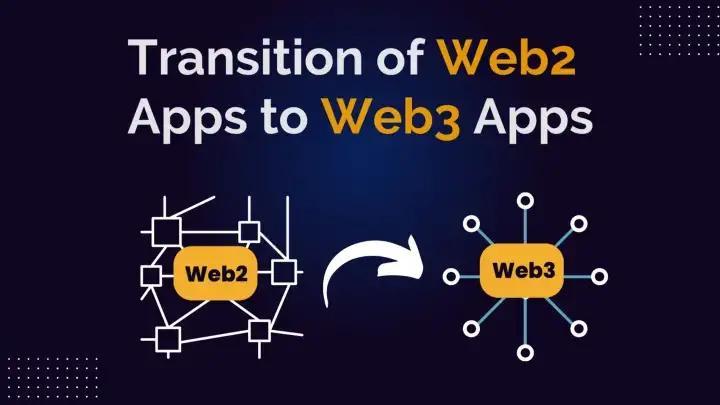Investigating the transition of Web2 applications to Web3 applications

The term “Web3” has gained popularity in recent years as people strive for “Decentralization.” This has evolved into a transparent method for users to contribute to the development of the future generation of systems and applications that will shape how we live, communicate with one another, and work.

As a result, there is clearly a migration from Web2 — which shapes the modern Internet — to Web3, which enables peer-to-peer transfers without the use of centrally controlled platforms and middlemen. This blog is completely for you if you want to learn more about Web2, Web3, the major differences between them, and the elements involved in the migration from Web2 to Web3.
What is Web 2.0?
Web2 refers to the current version of the Internet, which introduced user-generated content and placed a premium on interoperability and usability. Users can interact with data centers in real time, interact with other users, edit web pages, and post comments with this Internet version. Web2 does, however, have some limitations, such as the failure to remove outdated details, a lack of intelligence, a substantial percentage of scams, and so on.
What is Web 3.0?
The evolution of the internet has also been described as read, write, and own. It intends to give users control over the developments they construct as well as the information they create.
In Web 3.0 services there will be no single entity controlling the Internet in this scenario, and anyone and everyone can participate in an unreliable environment governed by consensus protocols.
FEATURES OF WEB 3.0
Decentralized: On web2, the internet is owned and controlled by a small group of people. However, on web3, users and developers can share ownership. Everyone can use Web3 in a similar way, ensuring that no one is left out.
Web3 does not use the traditional infrastructure of banks and financial processors to send and spend a fortune online. Instead, it makes use of cryptocurrencies like blockchain. It works without the assistance of trusted third parties. Instead, it employs economic mechanisms and incentives.
Aspects to Consider When Transitioning from
Web2 to Web3
1
. PAYMENT TRANSFER
Because Web3 employs decentralized currency, users should transition from a simple payment platform to a crypto wallet. Metamask is the best option, but users can also use third-party wallet libraries or APIs to meet their specific needs. Web3 wallets will give users access to a plethora of gaming and nonfungible tokens, as well as Decentralized finance and blockchain technology based crypto apps.
2
. STORAGE OF DATA
Web3 apps are distinguished from Web2 apps by their distinct data architectures. Web2 apps are application-centric and store app-specific data on a single server. Web3 apps, on the other hand, employ a user-centric data storage model that stores app data on a distributed network and allows users to access it.
Furthermore, unlike centralized data storage, where user data is used for personal gain, storage data ownership in Web3 belongs to the user.
USER-FLOW CHANGES
When we talk about user flow changes or user interactions as compared to Web2, Web3 will require more user interaction since smart contracts are used whenever tokens are sold, bought, transferred, or purchased.
migration
Token owner details must be stored in Web3 when a token is created by a user. In Web3, all the information about the current and previous owners of a token should be stored when a user sells or buys a token.
Furthermore, there are a number of challenges that you may encounter while migrating from Web2 to Web3, and let’s take a look at them now.
UI/UX enhancement challenges may be encountered during migration from Web2 to Web3.
3 .
Important factors that are required to be protected during the process of
better about web3 than web2 is that: It creates a decentralized ecosystem with peer-topeer transactions and services.The user owns the information.
is a need to protect data privacy. However, Web3 has already demonstrated its capability to enhance data security, since public blockchain data is challenging to commoditize.
key challenge is the lack of scalability of blockchains because most of them are still not able to scale as efficiently as Web2/fiat databases. Why should developers and enterprises use Web3 over Web2? Final thoughts You might wonder, “How do I build a stunning Web3 platform for my business?” or how to transition from Web2 to Web3 Platform successfully?
What’s
There
A
It would help if you now understood Web2, Web3, the benefits of migrating from Web2 to Web3, and some critical factors to consider when migrating from Web2 to Web3. You can contact a leading web3 development company such as MoogleLabs, which has extensive experience in providing the best web 3 solutions for various business models.
Contact our industry-experienced blockchain developers to successfully migrate your business from Web2 to Web3 within your budget and in a short time.
Source: https://bit.ly/3hIqCYg


